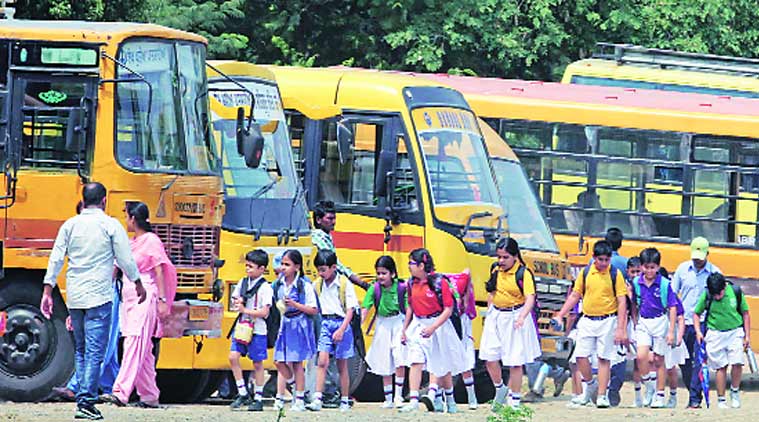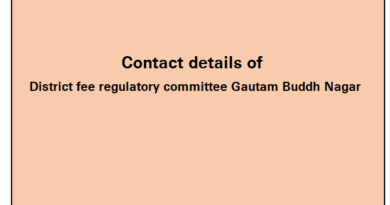School safety checklist that parents shall check, notice and report
Child safety in his or her School is a paramount concern for every parent today. Series of incidents of late have thrown to public scrutiny, the processes followed by Schools for child safety and security. It is important for parents to know what are the prescribed physical and emergency safety measures that Schools are mandated to follow. We bring below some of the CBSE guidelines with respect to Child safety in school. Based on a Survey done last year by SchoolBrainer, not even 10% parents are aware of more than 50% of these guidelines. Especially highlighted are those safety measures that every parent shall check and notice and report to school authorities in case of violation. Parents getting their child admitted to school shall also take these into consideration.
Tell us what your child’s school does not follow and we will as well write to them.
Physical Safety
| S. No. | Safety measures |
| 1 | The school maintains Health Cards as envisaged by the Comprehensive School Health Programme of the CBSE. |
| 2 | The school keeps the medical records of students with special health problems. |
| 3 | Parents communicate their child’s health issues to the school. |
| 4 | The school has a qualified full – time doctor and/or nurse in the school. |
| 5 | There is a doctor-on-call for emergency. |
| 6 | The school has tied up with a local hospital within two kilometers. |
| 7 | The medical room is fully equipped to handle all emergencies. |
| 8 | There is a first – aid box placed at every floor of the building. |
| 9 | The school carries out an annual medical check up of all the students. |
| 10 | The school staff is sensitized to understand the genuine health problems of the children. |
| 11 | The teachers have undergone basic training / bridge courses on counseling, first-aid and identification of disabilities/learning difficulties. |
| 12 | The school has a ‘Health and Wellness Club’. |
| 13 | Every teacher regularly makes use of the ‘School Health Manual’. |
| 14 | There is an emphasis on the intake of a balanced diet by the students and nutritious alternatives to junk food is encouraged. |
| 15 | The school follows a fruit-break, milk-break or mid -day meal plan. |
| 16 | There is a dietician and meal planner on the school panel. |
| 17 | The teachers have their meals with the students and monitor their eating habits. |
| 18 | The laboratories are well equipped to handle common emergencies. |
| 19 | The health climate is being fostered and evaluated on a regular basis in school. |
| 20 | The First-Aid protocol for common injuries is displayed at prominent places in school. |
| 21 | The school calls medical experts from time to time to sensitize the students and the teachers. |
| 22 | The school has constituted a parent-teacher-student committee to address the safety needs of the students. |
| 23 | The school has proper sewerage, drainage and garbage disposal arrangements. |
| 24 | There is a proper facility for safe drinking water with adequate number of water taps. |
| 25 | The auditorium, assembly hall and gymnasium are free from hazardous fixtures and are adequately lit up and well ventilated. |
| 26 | The access to school building by outsiders/visitors is controlled and monitored. |
| 27 | All the areas in the school are safe by design and are adequately supervised by the staff. |
| 28 | The staff actively supervises the students both inside and outside the classroom. |
| 29 | The benches have rounded edges. |
| 30 | The windows are fixed with proper railings and grills. |
| 31 | The washrooms are hygienic and the disinfectants are kept away from the reach of the children. |
| 32 | The electrical appliances are maintained and are regularly checked. |
| 33 | The secluded corners, corridors and staircases are kept under watch by staff during lunch breaks and at the time of dispersal. |
| 34 | There are ramps and wheel-chairs for differently abled students teachers and the school environment is disabled friendly. |
| 35 | The parents are connected with a messaging system or mobile phone networking. |
| 36 | The medical history of every student is available in the school. |
| 37 | The special records like blood groups, allergies and medication that need to be prescribed frequently are updated with parental support. |
| 38 | The physical education instructors are sensitive enough to involve students in sports according to their physical capabilities and health related issues. |
| 39 | The sports room is well – ventilated and well – equipped to handle common sports injuries. |
| 40 | The school playgrounds, swings, rides, sports – equipment etc. are safe. |
| 41 | The school buses have passed the safety test. |
| 42 | There is a teacher on board and a helper accompanying the children in the school buses. |
| 43 | The school buses are equipped with first – aid boxes, drinking water and mobile phones. |
| 44 | The elevators and exit ways are examined periodically and on a daily basis, and are maintained with a fitness certificate from the appropriate authorities. |
| 45 | The laboratories are safe and spacious enough for hazard free learning. |
| Emergency Safety | |
| S. No. | Safety measures |
| 1 | There are enough exits and entry points and staircases to be used in the case of emergency. |
| 2 | The evacuation plan is displayed at different places in the building. |
| 3 | The students and staff know and understand the evacuation plan to avoid stampede in case of a disaster. |
| 4 | The school premises is under surveillance by the Principal through CCTV’s. |
| 5 | There is a provision for legal alternatives and advice. |
| 6 | The staff has been trained to respond in case of an emergency. |
| 7 | The students and staff know how to use fire -extinguishers. |
| 8 | There are enough fire-extinguishers installed at sensitive places. |
| 9 | The floors, stairways and railings are safe. |
| 10 | CPR and first -aid classes are held at periodic intervals for staff and students. |
| 11 | The drain hole pipes and water tanks are covered properly. |
| 12 | There are fire- alarms and smoke-alarms installed at different places. |
| 13 | The disaster management drills and evacuation plans are practised from time to time. |
| 14 | There is provision for well-equipped ambulance in case of emergencies or during any disaster. |
| 15 | The protocols to be followed in case of emergencies are displayed at different places in the building. |
| 16 | The teachers and paramedical staff are trained to provide resuscitation. |
| 17 | The Fire Service, Ambulance Service, Police Service or any other Community Service can be contacted by immediate dialing. |
| 18 | The school is equipped with a Public Address System to make emergency announcements. |
| 19 | There is a stable Disaster Management Plan which is updated regularly. |
| 20 | There is a School Disaster Response Team consisting of members, administration, teachers and senior students. |
| 21 | There is a universal safety management language understood by everyone in the school. |
| 22 | The school staff is sensitized to address the trauma and post-disaster interventions. |
| 23 | The Principal is capable enough to take one or many crucial decisions incase of a disaster. |
| 24 | The school is equipped with school security technologies. |
| 25 | The school’s design is safe enough to handle terrorist attacks. |
| 26 | The school handles media briefing and updates without sensationalization. |
| 27 | The safety and security checklist is used for planning and designing new facilities or assessing existing ones. |
| 28 | The safety and security checklist of school is updated frequently. |
| 29 | There is a well-equipped disaster management cell in school. |
| 30 | There are regular preventive checks to ensure safety related to high risk areas-electrical, fire, civil work, school gates, transport etc. |
Reference: cbseacademic.in
Following are the circulars whereby CBSE directed schools to ensure safety of children in bus and school premises respectively:
http://cbse.nic.in/newsite/circulars/2017/Transport%20Circular%20dated%2023.02.2017.pdf
http://cbse.nic.in/newsite/circulars/2017/Circular%20Safety%20in%20School%2012.09.2017.pdf
Additionally, the government through NCPCR had in 2017, further defined safety and security guidelines for schools to follow:
http://ncpcr.gov.in/showfile.php?lang=1&level=1&sublinkid=1343&lid=1550
Again, National disaster managent (NDMA) also has prescribed guidelines for schools to ensure safety of children in case of natural calamities:
https://ndma.gov.in/images/guidelines/School-Safety-Policy.pdf
Other than the above, we have previously also touched upon bus related safety measures that are required to be followed.
[lastupdated]
Last Updated on September 5, 2018 by Go4Reviews




Pingback: EWS admission process in Gurgaon schools | Go4 School Reviews and More
Please check safety norms of SKS World School Grater Noida.
Right now they are moving in construction face and lot of labor present under school time. lot of time had watched in the morning time children slips on cemented ground in play ground area and the cry but principle busy in abusing to school teachers. the are following maximum 30% safety norms of School.
they have no proper instruction following as per School safety norms.
Thanks
Thanks for reporting Kaushal